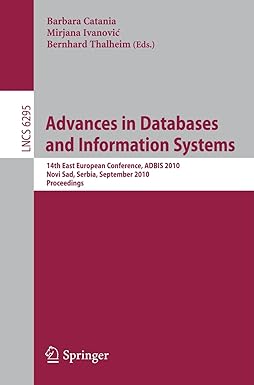Question
First program Give Music would like you to write a program that prints a summary of the albums in a given file. You should write
First program
Give Music would like you to write a program that prints a summary of the albums in a given file. You should write a program that does the following:
also to the given class add a function called extract_all_albums(lines) that reads all the albums that are in the list of lines. The function should return a dictionary that maps the id of an album to the corresponding instance of the Album class. here are all the test codes for this function that needs to be passed
For example:
| Test | Result |
|---|---|
example = [ "Angus's album listing ", " | Album id 100 Album Name: Now 1000 Band: Na Purchase Price: $27.50 Album id 101 Album Name: Best Birthday Songs Band: Serious Music's Purchase Price: $10.00 |
file = open('album0.txt') content = file.read() file.close() lines = content.splitlines() albums = extract_all_albums(lines) for album_id in albums: print(albums[album_id]) print() | Album Name: Licensed to Ill Band: Beastie Boys Purchase Price: $25.00 Album Name: Enter the Wu_Tang: 36 Cham... Band: Wu Tang Clan Purchase Price: $25.99 Album Name: Daydream Nation Band: Sonic Youth Purchase Price: $5.00 Album Name: 52nd Street Band: Billy Joel Purchase Price: $25.75 |
lines = [ "Angus's album listing ", " | True |
The input sequence of lines will contain zero or more album specifications of the form given in the previous question. There may be other lines between the various album definitions; you must ignore these lines. You may assume all albums are correctly formatted.
- Prompts the user to enter a file name
- Use the prompt 'Enter a data file name: '
- If the user enters an invalid file name then print 'Invalid File Name Entered!' and ask the user to enter a file name using the original prompt.
- Keep asking until the user has entered a valid file name.
- Reads the album data into the program as a list of lines.
- Processes the list of lines to extract all the albums as a dictionary.
- Prints a table as follows:
- Print a newline
- Print a title for the table: Album Catalogue Summary
- Print a separator of 35 '-' characters
- Print a line with the column headings 'ID' and 'ALBUM NAME' in the appropriate places (see format string below).
- Print a row for each album filling the columns, sorted by album ids. Use the format string below to get the columns lined up as required.
Notes:
- This format string may be of use: '{:<5}{:<30}'.
- The input data files contain sales sections which should be ignored at this stage.
- At the start of your program you should include the line import os
- You can use os.path.isfile(filename) to check if a file name is valid
the previous code:
class Album: """Stores the information about an album""" def __init__(self, album_id, name, band, cost): """The data that forms an album, note that: - album_id is a int - cost is a float - the rest are strings """ self.album_id = album_id self.name = name self.band = band self.cost = cost self.total_sold = 0 def add_to_sold(self, count): """Adds to the internal album counter of the album""" if count >= 0: self.total_sold += count else: template = "Attempt to add {} to Album: {}. VALUE MUST NOT BE NEGATIVE" raise ValueError(template.format(count, self.album_id)) def __str__(self): output = "" output += "Album Name: {} ".format(self.name) output += "Band: {} ".format(self.band) output += "Purchase Price: ${:.2f}".format(self.cost) return output def __repr__(self): return "<<{}>>".format(self.album_id) def extract_album(lines, index): """Insert your function here""" identity = lines[index+1].strip() album = lines[index+2].strip() band = lines[index+3].strip() price = float(lines[index+4].strip()) return Album(identity, album, band, price)
album0.txt
For example:
| Input | Result |
|---|---|
album0.txt | Enter a data file name: album0.txt Album Catalogue Summary ----------------------------------- ID ALBUM NAME 70 Enter the Wu_Tang: 36 Cham... 115 Daydream Nation 323 Licensed to Ill 414 52nd Street |
Step by Step Solution
There are 3 Steps involved in it
Step: 1

Get Instant Access to Expert-Tailored Solutions
See step-by-step solutions with expert insights and AI powered tools for academic success
Step: 2

Step: 3

Ace Your Homework with AI
Get the answers you need in no time with our AI-driven, step-by-step assistance
Get Started


